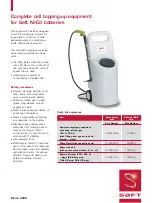
Page
6/14
A-5. CHARGER CONTROLS / CONNECTIONS
Euro power plug for 110-240V AC
POWER LED to show Power is on or off
4mm banana plugs (female) for all 7 outputs
LEDs to show the charge functions for all 7 outputs
A-6. INPUT CONNECTION
Connect the charger to an easily accessible 110-240V AC mains socket near to the charger.
A-7. CLEANING AND MAINTENANCE
The charger is entirely maintenance-free in use, and requires no servicing of any kind. However, it is in
your own interests to protect the unit from dust, dirt and damp.
To clean the charger, disconnect it from the car battery and any other battery, and wipe it clean with a
dry cloth (don’t use cleaning agents!).
A-8. NOTES AND HANDLING OF RECHARGABLE BATTERIES
• Charging single Ni-Cd or Ni-MH cells, and packs consisting of 1 ... 4 cells, presents the automatic
charge termination circuit with a difficult task. The voltage peak is quite small in such cases, and it
cannot be guaranteed that the cut-off circuit will work reliably. In such conditions the automatic circuit
may not be triggered, or may not terminate the charge at the correct time. For this reason it is
important to carry out a series of monitored test charge processes with your packs in order to
establish whether the charge process is terminated reliably.
• Warm batteries offer much higher performance than cold ones, so don’t be surprised if your batteries
don’t seem so effective in the winter.
•
Overcharging and deep-discharging batteries lead to irreparable damage to the cells, and
permanently reduces their maximum performance and effective capacity.
• Never store batteries for a long time in an uncharged, discharged or partially charged state. Charge
your batteries before storing them, and check their state of charge from time to time.
• When purchasing batteries we recommend that you buy good quality products exclusively. Start by
charging new packs at low rates, and work up gradually towards higher currents.
• Batteries should not be charged until shortly before use, as they are then able to deliver their best
performance.
• Do not solder directly to battery cells. The temperatures which occur during soldering can easily
damage the seals and safety valves of the cells. If this should happen, the battery may lose
electrolyte or dry out, and some of its potential performance will be lost.
• Charging any battery at high currents shortens the life expectancy of the pack. Don’t exceed the
maximum values stated by the manufacturer.
Summary of Contents for 6455
Page 24: ...Page 11 14 ...
















































